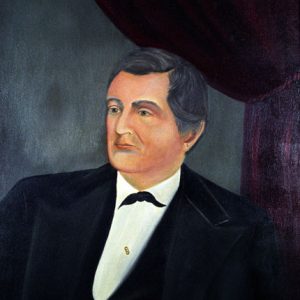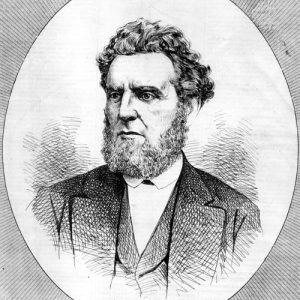calsfoundation@cals.org
Skirmishes in Little Rock and Argenta (Brooks-Baxter War)
While fairly serious combat took place at Palarm Creek and New Gascony (Jefferson County) during the 1874 Brooks-Baxter War, several skirmishes were fought in Little Rock (Pulaski County) and Argenta—now North Little Rock (Pulaski County)—in April and May before Elisha Baxter was declared the legal governor of Arkansas.
Hercules King Cannon White led militia troops, mostly Black, from Pine Bluff (Jefferson County) to Little Rock on April 18, 1874. On the early evening of April 21, he marched his troops to join Baxter in his headquarters at the Anthony House, on the southwestern corner of Markham and Scott streets, and offered their services, saying, “Furnish us simply with the means—give us the authority—pronounce the order—and I will guarantee to you, sir, that in twenty-five minutes from the time the order is written, Joseph Brooks will either be in hell or the archives,” which was met with riotous cheers from his followers. While Baxter urged White and his followers to show restraint, Colonel Thomas E. Rose, commander of U.S. troops in the capital, asked White if he was going to attack Brooks’s base at what is now the Old State House. Rose’s horse stumbled into some of White’s musicians, and in the confusion that followed, shots rang out from both Brooks and Baxter supporters, and ex-Confederate David F. Shall, a “wealthy real estate man and old and respected citizen,” was shot and killed as he stood in the Anthony House.
As militiamen on both sides began a confused firing, William Ayers Crawford and another Baxter officer were wounded, as were two of White’s men. A Brooks supporter was badly wounded in both legs, and an Anthony House maid broke her leg as she leapt in panic from a second-story window.
Rose then placed men of the Sixteenth United States Infantry Regiment with artillery on Markham to keep separate the Brooks forces at the Old State House and Baxter men at the Anthony House.
The largest engagement of the Brooks-Baxter War took place at New Gascony on April 30, and the steamboat Hallie was attacked at the mouth of Palarm Creek on May 8 before the major focus of violence returned to Pulaski County.
On May 10, White sent some of his cavalry to Argenta on the north side of the Arkansas River, along with Baxter volunteers from Lonoke (Lonoke County), to where they could attack Brooks men unloading “needle guns” and supplies from the steamboat Danville to bring to the Old State House. They took positions on the Cairo and Fulton Railroad lines, and soon some of Brooks’s followers crossed the river to confront them. According to a history written by John M. Harrell, “About 8:30 the firing was rapid on both sides, and the river bank lined with citizens watching the skirmish.” Colonel Rose sent U.S. troops to the railroad shops at Baring Cross (Pulaski County) and set up artillery at the foot of Louisiana Street to cover the low-lying land at Argenta.
Baxter’s men established a stronghold in the Little Rock and Fort Smith Railroad shops, and Brooks’s troops charged and tried to drive them out as “the workmen who remained in the shops lay on the floor to avoid the bullets.” Brooks troops suffered one dead and two wounded in the engagement, while four of Baxter’s followers were wounded.
Two days later, the steamboat Robert Semple, reportedly carrying more volunteers for Baxter, landed just above the Baring Cross Bridge, and Brooks’s followers were ordered toward the boat. Soon, “skirmishers were deployed by each side and firing commenced.” Brooks’s men took up positions in “old rifle pits” by Union Station, while Baxter’s infantry led by Thomas J. Churchill and William D. Blocher set up positions on 5th, 6th and 7th streets. Hercules White’s cavalry occupied the high ground around the state penitentiary and deaf-mute asylum.
For two or three hours, “the firing…was very heavy, rendering the streets unsafe for pedestrians and frightening families whose houses were struck by bullets.” U.S. troops double-timed from Broadway to break up a final skirmish at the corner of Second and Spring streets, but it had ended when they arrived, as had the day’s combat. Ten men were wounded in the day’s skirmishing.
The violence ended for the most part on May 15, 1874, when President Ulysses S. Grant signaled his support for Baxter, who returned to the Old State House on May 19, ending the Brooks-Baxter War and signaling the end of Reconstruction in Arkansas.
For additional information:
Harrell, John M. The Brooks and Baxter War: A History of the Reconstruction Period in Arkansas. St. Louis, MO: Slawson Printing, 1893. Online at https://archive.org/details/brooksbaxterwarh00harr/page/n3/mode/2up (accessed October 31, 2024).
Hefley, Jimmy. “The Brooks-Baxter War.” Arkansas Historical Quarterly 14 (Summer 1955): 188–192.
Mark K. Christ
Central Arkansas Library System


 Elisha Baxter
Elisha Baxter  Joseph Brooks
Joseph Brooks 



Comments
No comments on this entry yet.